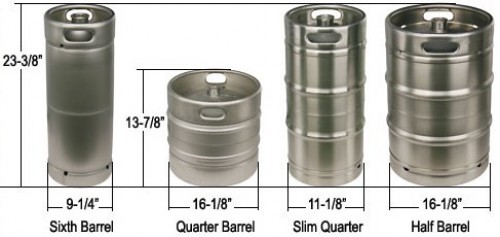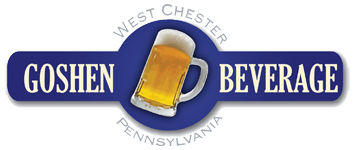KEG FAQs
We carry a large selection of draught beer, from standard domestic brands to kegs from various craft breweries as well as many imports. Please keep in mind, most draught beer is not pasteurized, therefore its shelf life is much shorter than case beer.
In order to provide you with the freshest and best possible product, we keep a limited number of kegs in store at any time.
If the beer you are looking for is not listed just give us a call, or send us an email and we will get it in for you!

Draught Beer Frequently Asked Questions
There are a lot of opinions and facts out there on this topic. This is a general discussion on the topic and does not account for all circumstances and opinions. I’ll start with some facts. Beer does not go bad…sort of! It only changes flavor. The 3 main components of spoilage are bacteria, oxygen, and temperature. The rate at which beer will spoil is dependent upon the combination of all three of these factors.
Let’s start with Bacteria. It is everywhere. You can’t get rid of it. There are good bacteria, ones that won’t make you sick, and there are bad bacteria, the kind that will make you sick. Beer does not support bad bacteria. It does support good bacteria. Over time, these bacteria will grow and impart a flavor in the beer. For the most part, these flavors are undesirable. The unique aspect of beer is that it has a natural bacteria inhibitor – Alcohol.
Next is Oxygen. Oxygen has two negative effects on beer. It provides fuel for more bacteria and it oxidizes the beer…changing the flavor. Once Oxygen (air) is introduced into the keg, it has only days before the flavor has changed substantially. It also goes flat. When you use a hand pump or picnic pump on a keg, the keg is pretty much done within 48 hours.
Finally there is Temperature. Temperature will inhibit or accelerate the growth of bacteria. The colder the beer, the slower the growth. The hotter the beer, the faster the growth.
What does it all mean? It means if you keep your beer cold, use Co2, not air to drive the beer, you keep the dispensing system clean, and you buy kegs from breweries that have strict sanitizing and cleaning procedures, you’re keg will last 4 months or more with minimal or no noticeable flavor change.
If you keep your kegs warm, and drive them with Co2 through a jockey box or other faucet, they will most likely last a couple of months. Just be sure to clean your lines after every keg.
- 1 barrel of beer=31 gallons.
- 1/2 Keg (1/2 Barrel) =15.5 Gallons or 1984 Fluid Ounces.
- 1/4 Keg=7.75 Gallons or 992 Fluid Ounces.
- 1/6 Keg=5.15 Gallons or 660 Fluid Ounces
- There are 165 12-oz. glasses in a 1/2 Keg
- There are 198 10-oz. glasses in a 1/2 Keg
- There are 124 16-oz. glasses in a 1/2 Keg
Temperature is a key factory in storing and dispensing draught beer. Beer can freeze at 28°F, so it is important to select and maintain proper operating temperatures inside the refrigerator cabinet. Optimum temperatures for serving cold beer are 34°-38° F (1°-3° C).
Using a standard kegerator, you should set the pressure regulator to ensure applied operating pressures remain constant (10-12psi/lbs). Using a coil box with 50′ coils, you should set pressure to 22-25psi/lbs.
Keeping your glassware clean is the key to serving good draught beer. To achieve this:
- Maintain strict sanitary conditions in the glass washing area
- Never wash glassware with utensils or dishes used to serve food. Food particles and/or residue can effect the quality/taste of draught beer
- Do no use regular liquid household dish washing detergents for glassware. They are fat-based and will leave a slight oily film on the glass. This causes beer to go flat quickly. Use a detergent designed specifically for beer glass cleaning. It must be low-suds, odor-free and non-fat.
- Avoid drying glassware with towels as they tend to leave traces of lint on the surface of the glass
- We recommend that you use beer glassware only for beer. Dairy and other food products leave a residue which can effect the quality/taste of the draught.
You can tell you have cloudy beer when the beer in the glass appears hazy, not clear. It can be caused by the following:
- Frozen or nearly frozen beer
- Old beer
- Beer that has been unrefrigerated for long periods of time
- Dirty glass
- Dirty faucet
- Unrefrigerated foods placed on top of cold keg
- Contaminated air source
ou can tell you have flat beer when the foamy head disappears quickly and the beer lacks usual zestful brewery fresh flavor. It can be caused by the following:
- Dirty glasses
- Sluggish regulator
- Applied pressure is set too low
- CO2 is turned off at night
- Contaminated air source (associated with compressed air)
- Moisture in air system
- Beer too cold
- Loose tap or vent connections
You can tell you have wild beer when the drawn beer is all foam, or too much foam and not enough liquid beer is present. It can be caused by the following:
- Beer drawn improperly
- Creeping regulator
- Applied pressure is set too high
- Hot spots in line
- Use of non-insulated beer line
- Beer runs are too long for proper cooling
- Tapped into a warm keg
- Cooler malfunctioning
- Kinks, dents, twists or other obstructions in line
- Faucets in bad, dirty or worn condition
You can tell you have unpalatable beer when the drawn beer has an off-taste. It can be caused by the following:
- Dirty or old beer lines
- Dirty faucet
- Contanimated air source, or unfiltered
- unsanitary bar conditions
False head appears as large soap-like bubbles and the head dissolves very quickly. It can be caused by the following:
- Applied pressure required does not correspond to beer temperature
- Small beer line into a large faucet shank
- Beer lines warmer than beer keg
- Dry glasses
- Improper pour
